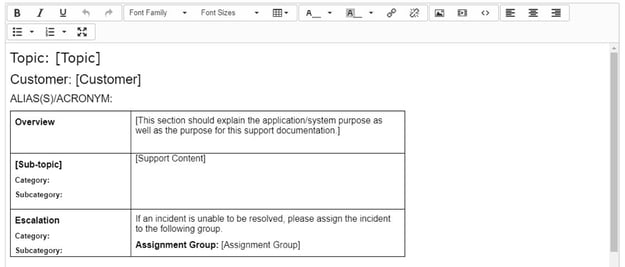Garbage in equals garbage out. Love or hate the saying, it rings true, especially when it comes to your Knowledge Base articles.
As a Lead Analyst in Quality Management at Crossfuze, I’ve invested a lot of time and effort to improving our Knowledge Strategy and developing best practices for creating a Knowledge Base. Below are five things you should implement into your Knowledge Strategy right away that will turn you into a Knowledge superhero at your company.
Consistency is paramount
Consistency is one of the most critical factors when it comes to an effective ServiceNow Knowledge Base. Even more so if your organization works with end-users from multiple clients or are expected to support a wide range of applications.
Your analysts likely won’t be an expert on every piece of technology that end-users calling in are using. By standardizing your articles so each one follows the same outline, process, and structure, you’re making it substantially easier for your analysts to work on the fly.
Here at Crossfuze, we utilize a two-column table format with topics/issues in the left-hand column and troubleshooting content and information in the right-hand column. The Knowledge Article Editor in ServiceNow allows us to easily and consistently format each article using templates and a multitude of tools. Below is an example of the template we utilize for each standard Knowledge Article.

What matters most is using a standardized format for your articles. So, take some time to research and determine the format that will work best for your specific situation and readers.
Base Your Articles on the Symptoms
When a user calls in, they’re going to describe the issue they’re having. This is typically something like, “My monitor won’t turn on.” Your analysts can then search for those symptoms in the ServiceNow Knowledge Base. However, if your articles aren’t written based on symptoms, it will be difficult for your analysts to find the right information quickly.
For example, we had a customer who was having issues with his docking stations – they didn’t recognize the monitor when a laptop was logged in. Since the issue was with the docking station, not the monitor, we, at Crossfuze, initially named the article “Docking Station Support.” However, when users were calling in with this problem, they would tell our analysts that their monitor wouldn’t turn on. Our analysts would search for monitor-related terms so the article they needed wouldn’t show up their search results. Once we recognized this issue, we renamed the article to “Monitor/Docking Station Sync Issue.” This made it much easier for our analysts to find because it was written using the same language that our callers used.
The Little Things Matter
As a knowledge or a QA manager, it’s critical to be detail oriented. The little things really do matter. Things like consistent and intentional use of font style, font size, and formatting throughout your entire Knowledge Base can impact your First Call Resolution (FCR) and Average Talk Time (ATT) stats.
Here at Crossfuze, we are very intentional with our formatting. For example, our standard is to use:
1. Bold for buttons or selections the analyst needs to click
2. Italics for any URL, email, or search terms
3. Red means the item is imperative to the process
4. Blue items are side notes that are useful but not critical to the process
Never Make Assumptions
Assuming that a step is so obvious it doesn’t need to be stated is a great way to allow mistakes to happen. When writing or updating your articles, you need to document every detail and every step that needs to be taken, even if it’s something your analysts do 100 times a day. Not only will this help new analysts learn and understand the right process, but it will help prevent more tenured employees from unintentionally skipping a step or cutting corners when they’re in a rush.
There is a point to be made about efficiency here. Pay attention to the flow of the article when adding details, as it can very easily become a confusing mess if you’re not careful. Put yourself in the shoes of an analyst and read the article as if you were attempting to troubleshoot the issue yourself. If you encounter any hang-ups or messy portions, clean it up by making sure the phrasing is concise and minimizing any clutter or busyness of the content.
You can also try reading the article out loud or having a colleague read it. Just because a sentence makes sense in your head, doesn’t mean there’s not another way to interpret it. Getting another set of eyes or ears on it will help identify any potentially ambiguous directions and catch errors or any missing information.
Update Your ServiceNow Knowledge Base Articles
You don’t need to block off massive chunks of time once a quarter or once a year to ensure your articles are up to date. You can use your ITSM platform to remind you when individual articles are at risk of getting stale, and you can build that review into your daily continuous improvement efforts.
The ServiceNow ITSM platform is the perfect tool for this job as it allows you to set an expiration date on every article. You can set this date manually or set it to a default to ensure it is reviewed consistently. When the expiration date is reached, a Feedback ticket will be created for the article and an email will be sent to all applicable persons advising them to review the article and update if necessary.

A Client Success Story
One of our clients, a food company with around 2,000 employees, leverages our Managed Services platform. When we first on-boarded them, their FCR was around 30% - well below our average. I dug into this problem to see why the numbers were so low and I realized that their articles broke every best practice I’ve listed above. I took the time to update everything. This included standardizing the formatting, fixing typos, reorganizing content to ensure good readability, and making the titles both consistent and based on the symptoms.
This was not a small undertaking, but it was critical to improving their FCR and giving them the amazing experience the rest of our customers have come to expect. Once this project was complete, we saw an almost immediate increase in their FCR – it went from 30% to 60% – and we’ve seen steady improvements ever since.
So, Where Do You Start?
If you are looking to improve your FCR and ATT, or if you’ve noticed that your analysts are having a difficult time finding and navigating articles, it might be time to revisit your Knowledge Strategy. It’s well worth the effort it may take to update and standardize every article.
I realize this can be a big project. But if you aren’t sure where to start, our ITSM consultants have helped clients kickstart these types of projects by making it a leadership opportunity for analysts. This gives your team a sense of ownership over the Knowledge Base, fosters a culture of employee development, and divides the workload so it’s not all dropped on one person.
Your ServiceNow Knowledge Base can do more than make your analysts more efficient. If built out properly, it can allow you to expand on your Service Portal, increase self-service adoption, and reduce the amount of tickets that come across your IT Help Desk.







